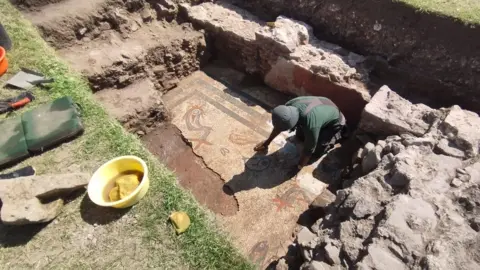
 Paul Belford/Heritage Innovation
Paul Belford/Heritage InnovationA 2,000-year-old mosaic has been discovered during excavations at a Roman site in Shropshire.
The piece at Wroxeter Roman City, near Shrewsbury, depicts brightly-coloured dolphins and fish.
It was uncovered during work to search for the main civic temple.
“Our excavations were in hope of discovering the walls of this building, but we never suspected we would find a beautiful and intact mosaic, which had lain hidden for thousands of years,” said Win Scutt, from English Heritage.
 English Heritage
English Heritage“It’s always an astonishing moment when you uncover a fragment of beauty hiding just below the ground,” he added.
Archaeologists who made the discovery said the mosaic dated back to a time soon after the city was established, and would have been commissioned by a “wealthy and important person”.
The team also found coins and pottery and a painted plaster wall on one side of the mosaic, which experts said would help date the phases of the city, and the activities that took place there.
The area of excavation has been reburied for protection and preservation.
 English Heritage
English HeritageWroxeter, once known as Viroconium Cornoviorum, was established in the 90s AD.
It contained a civic bath house, market place, county hall and judicial centre as well as more than 200 houses.
Today, a number of ruined buildings are the only remains of the city above ground, and are cared for by English Heritage.
The excavation was a collaboration between English Heritage, the University of Birmingham, Vianova Archaeology and Heritage Services, and Albion Archaeology.
In July, archaeologists found a large monumental building on the city’s main road, and a shrine or mausoleum which may have honoured an important individual.




:focal(1160x380:1162x378)/origin-imgresizer.eurosport.com/2024/09/23/4043858-82014808-2560-1440.jpg?w=150&resize=150,150&ssl=1)


Leave a comment:
You must be logged in to post a comment.